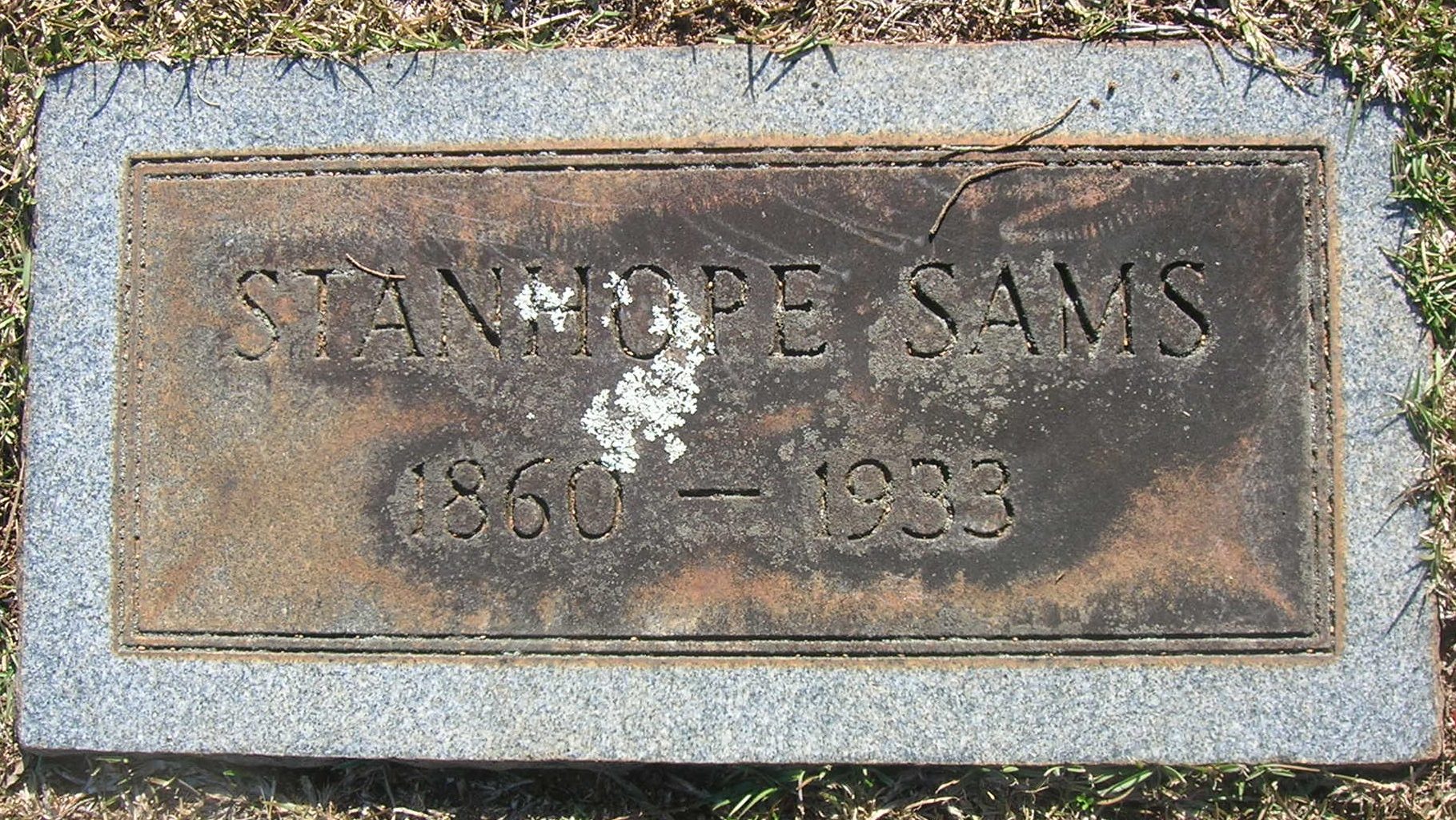Headstone for Dr. Miles Stanhope Sams (1860 – 1933), Elmwood Memorial Gardens, Columbia, S.C.
In 2020 I originally published a series of articles on the Sams of South Carolina entitled 52 Sams in 52 Weeks. While researching the family, I came across a Sams that had moved to Japan in the early years of the 20th century. M. Stanhope Sams had an exciting life and was quite a Renaissance man.
Miles Stanhope Sams (1860 – 1933)
Miles Stanhope Sams was the grandson of Lewis Reeve Sams (1784 – 1856) and his first wife, Sarah Fripp (1789 – 1825). He was the son of the Reverend Marion Washington Sams Sr. (1822 – 1899) and Mary Lucia Duncan (1856 – 1902). It is widely reported that he was born on 11 Dec 1860, but I believe this is incorrect. His parents and the family are listed in the 1860 Federal Census, taken in September of that year, and Miles Stanhope is identified as 6/12 years old. Therefore, I believe he was born in March of 1860. Stanhope, who went by his middle name as an adult, was the sixth of their seven children. All but one lived to adulthood. By the time he came along, the family had moved away from Beaufort to Greenville, SC, possibly due to the looming war or to seek opportunities elsewhere. By 1870 his mother and father had moved the family to Decatur, GA, where they spent their last years.
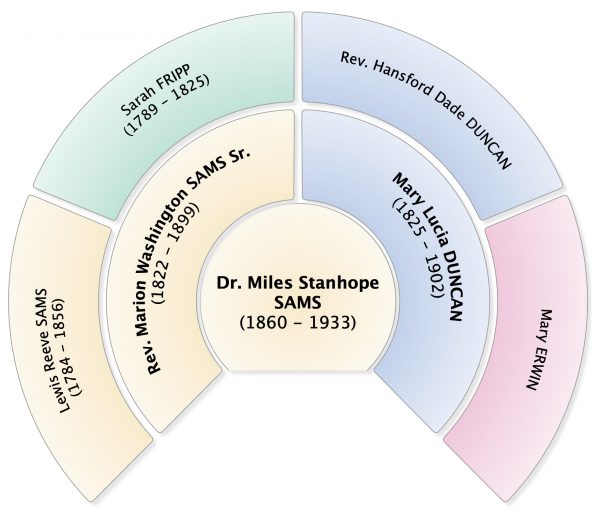
Education
M. Stanhope Sams went away to college in the late 1870s at Vanderbilt University in Nashville, TN. He was on course to becoming a Renaissance man. The Vanderbilt yearbooks of the era show Stanhope took classes in Latin, English, Modern Languages, History, English Literature, and Criticism (!?) for the first two years, then two years of Law. At some point in his career, he received an honorary Doctor of Literature degree from Newberry College, a school with a long Lutheran association located northwest of Columbia, SC. For nearly all his professional life, he went by Dr. Stanhope Sams.
Dr. Stanhope Sams married Camilla Johnson (1866 – 1948); they had no children. We don’t know when they married, but Camilla accompanied her husband when they moved to Tokyo, Japan, in 1911.
International Correspondent
Dr. Stanhope Sams was a writer, and his interests varied widely. Not surprisingly, he became a journalist; what I think of today as an international correspondent.
He was a reporter for the Augusta Chronicle, then editor of the Atlanta Journal. Decatur, where his parents had moved about 1870, is a short distance east of Atlanta. These publications effectively brought him home. By 1890 Stanhope Sams was a reporter for The Tribune and The New York Times, even serving in 1898 as a war correspondent in Cuba.
As the 20th Century opened, Dr. Stanhope Sams had become an editor of Collier’s Weekly, then associate editor of Gunton’s Magazine from 1903 to 1904. This second publication was devoted to economics and political science. In 1904, Stanhope Sams penned articles for the magazine with these titles,
- Audacity
- The Venezuela Decision—A Catastrophe
- The Interest Of Civilization In The Russo-Japanese War
Here’s a snippet of an interesting article he contributed in 1905 to The Tribune, and a hint of what’s coming.
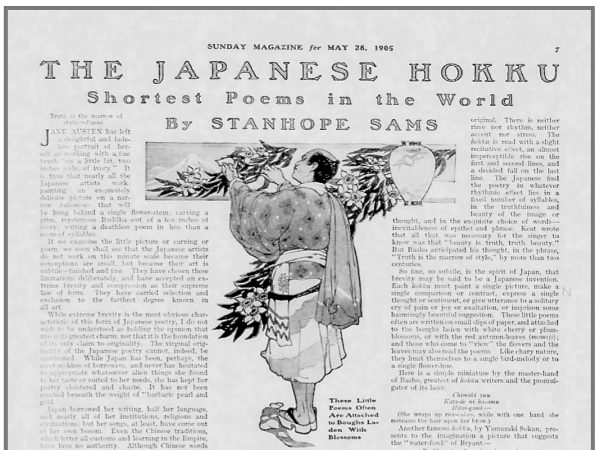
Japan
Come 1905, he moved to his long-term home at The State in Columbia, S.C. He served as both an editorial writer and a literary writer for nearly 30 years, except for his sabbatical (of sorts) in the Far East. In 1911, he began international work and became editor of The Japan Times in Tokyo, Japan.
The Japan Times was a daily newspaper published in English with a portfolio of reporting on all fields of Japanese life and industry to the people of the West. Newspapers all over the Southeast reported on his selection for this position. Of course, the South Carolina coverage showed a particular pride in their native son. But even the Evening Chronicle out of Charlotte, North Carolina, reported the event with a touch of hyperbole,
“The [Japan] Times says of Dr. Sams, who is a Southerner, that probably he is the most remarkable and accomplished linguist in the country. Besides being master of all the European languages he is the leading authority in this country on Persian literature and language, and one of the few Americans able to speak, read and write Japanese fluently. While engaged on New York newspapers he edited a Japanese-American magazine as a side line. His knowledge of the language was a strong factor in securing for him the remarkable appointment that has just come to him.” 17 April 1911
Reports later in his life were more pragmatic about his language fluency when he first went to Japan, but in any case, he was exceptional with languages. Dr. Sams and his wife Camilla spent four years at The Japan Times before he was appointed as the U.S. Trade Commissioner in the Far East – after a competitive down-selection from 70 candidates.
U.S. Trade Commissioner in the Far East
Dr. & Mrs. Sams returned to the U.S for a short while for him to accept his new post with the United States Department of Commerce before heading back to the Far East late in 1915. Again, his assignment drew coverage from papers all over the U.S. His mandate was to investigate export markets for U.S. manufacturers of wearing apparel, so he toured factories around the Eastern U.S. for a few months before setting sail in September 1915 for Yokohama, Japan. His portfolio included not just Japan but also China, Korea, Manchuria, Formosa (Taiwan), and Australia – based on newspaper coverage of his reports back to the Commerce Department.
As you can imagine, being an agent of the U.S. Government looking for trade opportunities made them a popular couple in Japan. They made journeys throughout the empire and its many islands. One report says, ”Among men whom he knew well were the government ministers and some of the great nobles; Barons Kato, Makino, Goto, Tokugawa; Mr. Ozaki, mayor of Tokyo, later minister of justice; Baron Sakatani; the leading businessman, Baron Shibusawa – upon whom he wrote an article for the American Review of Reviews; other prominent business leaders, such as Baron Nakano, Asano the shipping king.”
Of his language skills, it says, “Reading already German, French and Spanish, with considerable fluency in speaking them, and having also some facility in Italian, besides having been well-grounded in Latin and Greek, Doctor Sams quickly acquired Far Eastern languages. While in Tokyo, he learned to talk and read Japanese (in Roman and somewhat in the native character) and became familiar with some 900 to 1,200 Chinese signs or ideographs necessary for reading Japanese and Chinese. He knew Arabic fairly well and had done considerable research in other Oriental languages.” [The State, 1933]
I cannot imagine being able to do this. However, some people hear the music in languages and are just more able to learn them well.
He and his wife returned to the United States in July 1917 as the World War was continuing; Japan fought with the Allies against Germany, but traveling in the region was becoming more difficult. He stayed in the government, synthesizing accumulated trade information into a usable form until November 1917, when he returned to the staff of The State in Columbia, S.C. He continued there until his death in 1933 from a stroke while summering near Asheville, N.C.
And one last story before I wrap this up. This is the kind of gem that makes this research so enjoyable.
Art Critique
The advantage of his being a newspaperman is that I was able to find many, many articles written by Dr. Stanhope Sams. This art review of his piqued my interest.
The Covered Wagon is a 1923 American silent Western film released by Paramount Pictures and was the most popular movie of 1923 in the U.S. and Canada. President Warren Harding showed it at a special screening at the White House during that summer. [Wikipedia] This “silent film” had only music and subtitles. The first feature film originally presented as a talkie was not released until 1927; The Jazz Singer.
To more fully appreciate what appears to be a simple Western, consider this detail about making the movie. “The covered wagons gathered by Paramount from all over the Southwest were not replicas but the real wagons that had brought the pioneers west. They were cherished heirlooms of the families who owned them. The producers offered the owners $2 a day and fed for their stock if they would bring the wagons for the movie. Most of the extras seen on film are the families who owned the covered wagons and were perfectly at home driving them and living out of them during the production.” [Wikipedia]
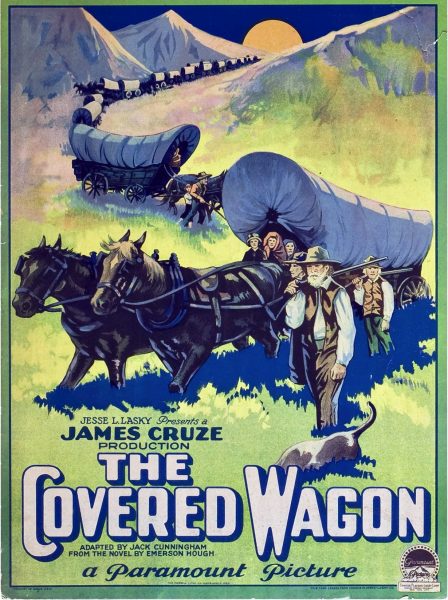
As the Art Critique for The State newspaper, Dr. Stanhope Sams reviewed this film. His conclusion about The Covered Wagon is remarkably prescient.
“The Covered Wagon is probably the greatest picture-play—all things, and so many things they are, considered—that the silent stage has yet given us. And yet it is typical and is a promise, as well as an assurance, of what greater achievement are awaiting this new and unlimited art. It makes the gulf between the old and the new art of the stage wider by leagues. And it presages the ultimate separation of the two. The world is big enough for both … while the new stage or theater is but entering upon dawn at the beginning of its great march.
You must see “The Covered Wagon”—in justice to yourself and to have a new “tradition” to pass on to others. STANHOPE SAMS.”
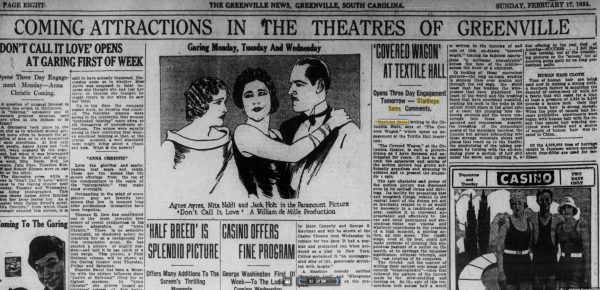
The Covered Wagon is no longer under copyright protection, so you can watch the entire 100-minute movie on YouTube. Kind of eery to imagine you are watching the same film Dr. Stanhope Sams did over 95 years ago.
Sources
Gunton, George – Editor of Gunton’s Magazine, Volume XXVI, January-June 1904
Holden, Joel and Riski, Bill – The Sams Family Tree, Ancestry.com, accessed May 16, 2020.
Wikipedia for The Covered Wagon, Vanderbilt University, and Newberry College.
New York Tribune Sunday Magazine, 28 May 1905
The Times and Democrat, Orangeburg, S.C. 1 Apr 1911
The Evening Chronicle, Charlotte, N.C., 17 Apr 1911
The Honolulu Advertiser, Honolulu, HI, 29 Dec 1914
Evening Star, Washington D.C., 1 Aug 1915
The Coffeyville Daily, Coffeyville, KS, 6 Aug 1915
The Canton News, Canton, MO, 5 July 1917
The Burbank Review, Burbank, CA, 3 Aug 1917
The Gaffney Ledger, Gaffney, S.C., 29 Nov 1917
The Greenville News, Greenville, S.C., 17 Feb 1924
The Atlantic Constitution, Atlanta, GA, 19 Sep 1926
The State, Columbia, S.C., 15 July 1933,
#52Sams Week 20 – Travels of a Renaissance Man


